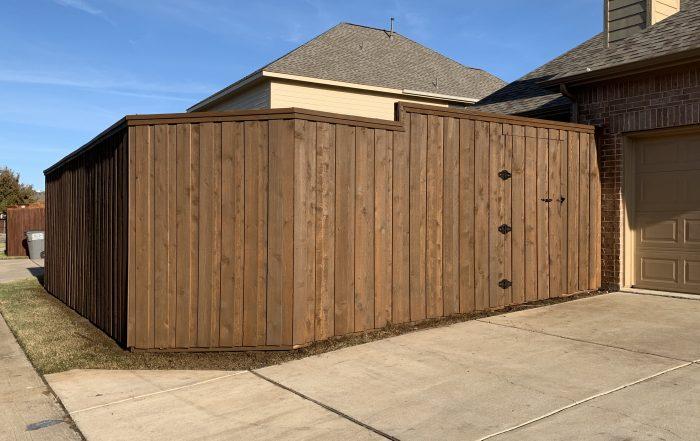
Preparing Your Fence for Spring
As January draws to a close and the warm weather of winter persists, it’s an opportune time to focus on the maintenance of your winter fence to ensure their longevity and resilience.
As winter continues to unfold its chilly embrace, North Texas experiences occasional warm spells, providing a golden opportunity for homeowners to engage in some essential fence maintenance. At Fence Makeovers LLC, we understand the importance of preparing your fence for the upcoming spring, and one crucial task is trimming down bushes or tree limbs that may be encroaching upon your fencing.
We’ll share the significance of addressing this task during the winter months and guide you on the best practices to ensure a pristine and durable fence as we transition into the blooming season.
Why Trim Trees and Brush on a Winter Fence Before Spring?
- Preventive Measures: The winter offers a special opportunity to guard against future damage to your fence. By keeping shrubs and tree limbs from tangling with the winter fence, you lower the possibility that strong, unforeseen storms could cause structural damage.
- Promote Air Circulation: The area around your fence can have improved air circulation when the vegetation is well-trimmed. This is especially crucial for avoiding moisture accumulation, which can cause mold, post rot, and other problems that jeopardize the structural integrity of your fence.
- Prevent Pests: Insects, raccoons, and squirrels can use overhanging branches as thoroughfares to enter your property. You reduce the possibility of intruders causing harm or building nests nearby by pruning these branches away from the fence. Squirrels in the Dallas region have the potential to become a serious annoyance because they are deficient and chew off your fence due to a shortage. More details regarding squirrels are available here.
Best Practices for Winter Fence Tree Trimming
- Assess the Terrain: Examine every plant that surrounds your fence in detail. Look for any overgrown shrubs or tree branches that could endanger the building. Be mindful of any branches that are touching or adjacent to the fence.
- Select the Correct Equipment: For efficient trimming, spend money on good pruning shears, loppers, and a small handsaw. To make the task easier and avoid putting undue strain on you and the plants, make sure your instruments are sharp and well-maintained.

- Trim Strategically: Removing tree limbs to safeguard your fence is a proactive tactic essential for maintaining the durability and structural soundness of your fencing. Overhanging branches pose a serious threat, especially in winter when the weight of snow and ice might cause them to break and fall onto a building. Routine trimming creates a buffer zone around these limbs, reducing the chance of a direct hit. This not only shields the fence from wear and abrasions due to frequent contact but also averts potential damage.
Prioritize trimming off any branches that are dead or injured, then any branches that are too near the fence. To promote healthy growth, keep a balanced look and take into account the plants’ natural shape when pruning. Adequate trimming promotes good air circulation, lowering the possibility of moisture-related problems that could weaken the fence’s longevity. Adopting this approach ensures a well-maintained winter fence and enhances the appeal of your outdoor space.
- Get Rid of the Debris Correctly: As soon as the branches and limbs are trimmed, take them off and dispose of them right away. This keeps the area around your property neat and stops the abandoned plants from becoming a haven for pests.You can arrange for your waste management business in the Dallas region to take up your brush or tree limbs on a day when they are handling your trash collection. Make sure these are organized neatly, and do not bundle limbs longer than four feet.
Take advantage of the odd warm weather that arrives in North Texas as winter approaches to give your fence the attention it needs. In order to create a colorful and healthy spring landscaping, cut wintertime branches and shrubs away from the fence. To protect your fencing investment over time, Fence Makeovers LLC advises preventative upkeep. Accept the winter as an opportunity to strengthen your fence, and in March you will be rewarded with a beautiful outside area.
Remember, a well-maintained winter fence not only enhances the aesthetic appeal of your property but also adds to its overall functionality and value. Stay tuned for more expert tips and insights from Fence Makeovers LLC to make the most of your outdoor space throughout the changing seasons.
When it comes to making decisions about your fence, seeking a second opinion can make all the difference. At Fence Makeovers, we understand the value of informed choices for your fencing needs. That’s why we offer a free estimate for our services, providing you with the opportunity to explore your options without any commitment.
Our team of experts is ready to assess your project, offer valuable insights, and present you with a comprehensive written 30-day estimate of your fence makeover possibilities. Take advantage of our commitment to transparency and quality – schedule a free estimate today. Let Fence Makeovers be your trusted partner in transforming and enhancing your outdoor space. Thousands of our customers do and if you need more confirmation check out our A+ Rating with the BBB of Dallas!
Cedar Fence Maintenance: The Key to a Lasting, Beautiful Fence
Does Your Cedar Fence Need a Summer Makeover? Cedar fence maintenance isn’t just a seasonal chore—it’s the foundation of a fence that stands strong and stunning year after year, [...]
The Real Cost of Ignoring Fence Maintenance
Fence Neglect Is More Expensive Than You Think In North Texas, your wood fence isn’t just a boundary—it’s a statement of pride, protection, and property value. At Fence Makeovers, [...]
Fence Staining in Plano, TX and Surrounding Cities
Protect, Beautify, and Extend the Life of Your Fence When it comes to maintaining the beauty and longevity of your wood fence, staining isn’t just about aesthetics—it’s a powerful way [...]



